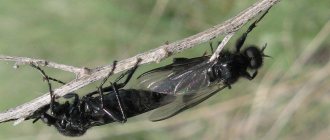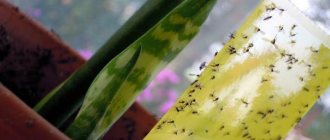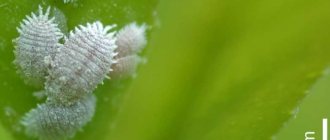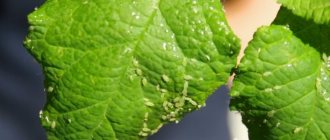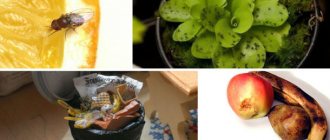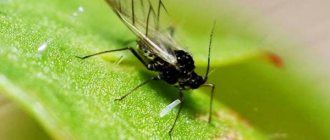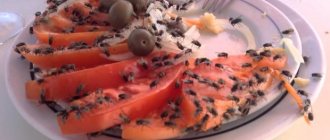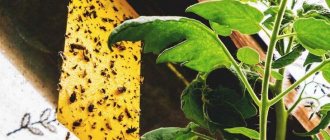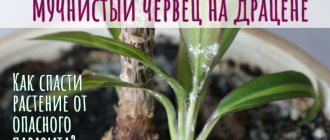Potassium permangantsovka
When midges appear, you must first let the soil dry, and then replace the irrigation water with a weak solution of potassium permanganate. You only need a few grains per liter of water so as not to burn the roots. The plant can also be sprayed with this composition.
Potassium permanganate has a good effect in the fight against fungus in the soil. If you smell mold, dry the soil and water it with a pale pink solution.
It is not recommended to use the product on an ongoing basis. This can disrupt the acid-base balance of the soil and lead to the accumulation of manganese in the soil. As a result, not only pathogenic microorganisms will die, but also beneficial bacteria.
Sulfur from matches
Sulfur is part of complex fertilizers. In addition, fungicides based on this microelement are used for treatment at the first signs of a fungal disease.
To rid indoor flowers of pests, experienced flower growers stick matches into the ground with their heads down. After some time, the midges and their larvae will disappear, and the plant will receive almost free feeding.
The disadvantages of this method include the need to frequently change matches: the sulfur on them dissolves in one day. Wooden sticks left in the soil can rot and cause pathogenic flora to multiply.
Garlic
Strong antibacterial agent. Its smell cannot be tolerated by insects. If you are not afraid of a specific aroma, water your indoor flowers with garlic infusion.
Garlic destroys mold spores, prevents plant diseases and repels all insects. It is necessary to chop 7-10 cloves of garlic, pour a liter of boiling water over them and leave for at least a week.
Strain the resulting concentrate, measure out 50 g and stir in 10 liters of water. This solution can be used to both water and spray plants.
A simpler, but less effective way is to put a few cut cloves in a flower pot.
Advantages of using garlic: getting rid of pests, preventing plant diseases and saturating the soil with useful substances. The disadvantages include a pungent odor, the duration of preparation of the infusion and its short shelf life.
Reasons for the appearance of midges in flowers
Let's figure out why this problem arises - the appearance of midges in flowers
. There are several reasons why midges appear on plants; you should know them in order to properly care for your flowers.
First reason
– the soil was initially contaminated with midge larvae. Next time, remember that before planting plants in the soil, it must be disinfected.
In addition, the soil should be periodically treated against pests for prevention. This will prevent the appearance of parasitic colonies in the soil.
The second reason
– excessive waterlogging of the soil, especially in winter. This happens due to abundant and frequent watering - the water in the pot stagnates and contributes to the appearance of unwanted insects.
Third reason
– a constantly open window through which midges fly in and settle in the damp soil.
Fourth reason
– fallen leaves of plants that begin to rot in the pot, creating favorable conditions for the appearance of pests.
If you regularly carry out preventive disinfection of the soil and follow all the conditions for caring for plants, you will never have the question of how to get rid of midges from flowers in a pot.
Tobacco infusion
To prepare the product, tobacco dust, shag and dry tobacco leaves are suitable. Approximately 400 g of powder should be poured into 10 liters of water at room temperature and left for a day.
After a day, strain the mixture and spray it on indoor plants. Nicotine, which is part of tobacco, kills all insects.
To better retain the liquid on the leaves, you need to add a little laundry soap to the resulting composition.
Caution should be used: use a protective mask and store separately from food. Nicotine is a poison not only for insects, but also for humans.
It can cause dizziness, nausea, and heart rhythm disturbances. This substance is especially toxic to children and pets.
Cold
All insects love a warm and humid atmosphere, and cold has a depressing effect on them. Sometimes it is worth taking flower pots out onto the balcony, especially in early spring and late autumn.
The cold will not only destroy pests in the soil, but also harden the plants. First you need to find out which colors are indicated for such procedures. For example, geranium and fuchsia can easily tolerate temperature drops of up to 10 °C.
However, not all plants are so patient. Even a slight drop in temperature can cause the death of heat-loving tropical crops, in which case complex measures will have to be used to combat insects.
Lemon or lime zest
A cheap way to kill harmful insects is to use citrus peels. They will not only repel pests with volatile phytoncides, but will also become a vitamin supplement for the root system.
You need to break the lemon or lime peels into pieces and put them in a flower pot. This procedure should be carried out several days before the next watering, so that natural waste does not mold on wet soil.
The disadvantages of the method include the short duration of its action: when dried, citrus peel quickly loses its effectiveness.
Varieties of white bugs
In the soil of indoor flowers, one miniature insect goes unnoticed. But after a few days, a colony of pests actively sucks out the plant’s juices. External signs of infection: spots on leaves, stems, curled leaves, wilted flowers, fallen buds.
There are several types of white pests:
- Aphid. The maximum size of an adult is 2 mm. The colors of aphids are very diverse; on indoor plants they can be found in light gray, white, green, red, etc. The body has an elongated shape, small legs, and straight antennae. It reproduces extremely quickly. Small white bugs feed on the juices of the plant, thereby leading to the complete death of the crop.
- Spider mite. White insects appear suddenly in the soil of indoor plants, unnoticed by humans. The mite body size does not exceed 2 mm. When flowers are heavily infested, a clear symptom of the presence of this pest is the presence of cobwebs on the back of the leaf. The result of the vital activity of the parasite is spots, dried, curled leaves. Females take refuge in the soil, under rotting leaves.
- Root mite. Insects live in flower pots in moist soil. They parasitize bulbous plants - tulips, gladioli, hyacinths. They live directly in the soil, feeding on the bulb itself. As a result of active life activity, the flower gets sick and dies.
- Mealybug. Small white bugs in indoor flowers no larger than 3 mm in size. An oval flat body with growths, covered with a dusting in the form of flour. Long tentacles are visible on one side. A sign of the life of a mealybug is a white coating on the leaves, stems, and soil.
- Springtails. Small bugs with an oblong, translucent body live in soil with high humidity. They feed on dead organic matter and do not harm the plant. Externally, the springtail is similar to a caterpillar, but with legs. The mustache is clearly visible on the head.
White pests
White bugs on flowers can disappear on their own if living conditions change - the soil dries out, the temperature drops, etc., but in most cases human help is required. Otherwise, the plant gets sick, dries, loses strength, and dies.
Mosquito fumigator
The compositions that are filled with purchased fumigators are an excellent means of combating flower midges. They do not kill the larvae in the flower pot, but only repel insects for several hours or days.
In addition, they are used up quite quickly. Therefore, the method, despite its ease of use, is not the most effective.
The room must be ventilated from time to time to avoid dizziness, headaches and allergic reactions, which can be caused by low-quality products at a low price.
Midges in a flower pot
The coziness and comfort of the room, from properly selected indoor plants, can be disturbed by troubles from which no one is immune.
From time to time, fans of potted flora encounter the appearance of midges in a flower pot. However, soil gnats do not appear in all indoor plants. “Soft” stems and leaves are susceptible to insect attack. For example, begonia, rose or violet.
If measures are not taken, the plant will die, since these are not only insects living on the outer parts of the plant, but also larvae living in the soil. Eggs and adults can coexist in houseplant flowers at the same time, creating new generations of pests.
Throughout their life, midges leave their products in other flowers, gradually infecting the entire home flora.
Insecticide
The most effective way to combat any harmful insects is the use of professional insecticides. Good results in pest control can be achieved with drugs containing imidacloprid or thiamethoxam. These substances are synthetic analogs of nicotine.
Based on them, many pest control products have been created. When sprayed, the drug penetrates the above-ground parts of the plant and remains there for a long time.
The substance itself does not harm plants, but kills insects that land on them. Worms and larvae living in the soil also die.
Like the use of any chemical pesticides, the use of such products can negatively affect the health of people and animals. Bio Spark is considered the safest drug containing a small dose of imidacloprid. When working with it, you must wear gloves and a respirator, and then thoroughly ventilate the room.
How to get rid of worms
Regardless of which pest has settled in home flowers, they all live in the soil. It is hardly possible to simply remove them from the ground. Transplanting into a new soil mixture will help only if the infection occurred recently and the colony has not had time to grow. It's done like this. The roots removed from the soil are carefully examined. All infected or damaged areas are removed and the sections are disinfected.
All adult parasites are removed or washed off from the root shoots. Larvae and eggs cannot be removed this way. Therefore, immediately after transplantation, the soil mixture is treated with an insecticide solution. It must be understood that this technique will be effective only if the number of insects is small. In other cases, chemicals or folk remedies will help. It's better to start with non-toxic methods. If they don't help, move on to stronger remedies. We offer effective ways to get rid of worms in flower pots.
Insecticides
For control, different types of insecticidal preparations are used. We offer a list of the most effective ones.
Insecticides
"Inta-vir". Nerve poison. Causes the death of parasites within 24 hours. The eggs remain intact. "Carbation". Sterilizes the soil, protects flowers during budding and flowering. Can be used once. Fumigator type drug. "Confidor". Penetrates into plant tissues and remains in them for a long time. Worms are insensitive to it and only kills insects. "Fitoverm". Paralyzes the nervous system of worms and insects. Twice application is recommended. "Agravertine". Effective against all types of parasites, non-toxic to humans. In hot weather its effect is enhanced.
Before getting rid of worms using insecticides, you must carefully read the manufacturer's instructions. The drugs are toxic, so it is necessary to strictly follow the dosage and safety rules. Otherwise you may get poisoned.
Folk remedies
These drugs are non-toxic and not dangerous to people or pets. But their effectiveness is lower than that of insecticides. Perhaps they will not help in the fight against a large colony, but at the initial stage or as a prophylactic agent they are quite effective. We offer a list of methods on how to get rid of white worms in flowers.
Non-toxic techniques
Prepare a water solution of soap. It is best to take household goods, made according to GOST, with a high fat content. Soap shavings are diluted with water, and the resulting solution is sprayed on the infected bush. The treatment is repeated several times. Dissolve 5 g of tobacco leaves ground into dust in a liter of clean water. Allow the drug to brew for 24 hours. Spray the infected bush and the soil in the pot generously. Treat the bush in this way every 6-7 days for a month and a half. Dissolve potassium permanganate crystals in water to obtain a pale pink liquid. Water the flower bush with it. Repeat the treatment several times. Place garlic cloves or citrus peels on the ground inside the pot. You can treat the soil with a strong-smelling oil, such as anise or rosemary.
Some flower growers are confident that sulfur from matches will help get rid of parasites. It is scraped off and the powder is sprinkled on the soil, or matches are simply stuck near the stem with the heads down.
Country cottage area
How to get rid of whiteflies on home flowers and seedlings
